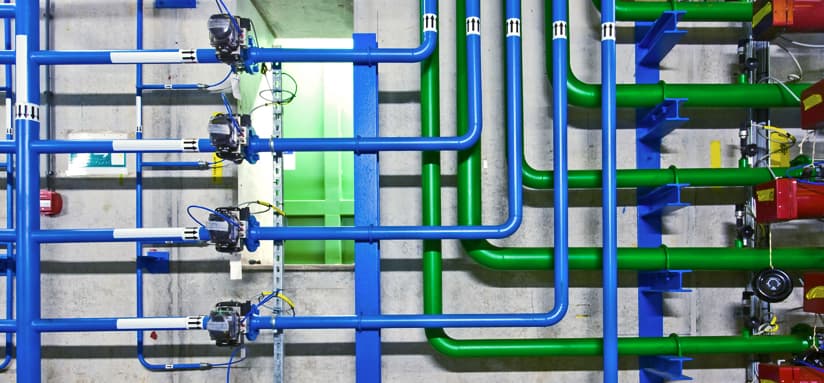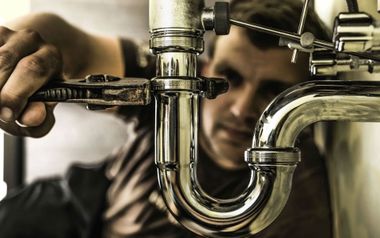Breaking Down Your Home's Plumbing System Anatomy
Breaking Down Your Home's Plumbing System Anatomy
Blog Article
We've uncovered the article involving Plumbing Installation 101: All You Need to Know below on the net and felt it made good sense to discuss it with you on this page.

Understanding exactly how your home's plumbing system works is necessary for every single homeowner. From delivering clean water for drinking, cooking, and bathing to securely removing wastewater, a properly maintained plumbing system is crucial for your household's health and convenience. In this thorough overview, we'll discover the detailed network that composes your home's pipes and offer suggestions on maintenance, upgrades, and taking care of common problems.
Introduction
Your home's plumbing system is more than just a network of pipes; it's a complicated system that ensures you have accessibility to clean water and efficient wastewater elimination. Recognizing its elements and just how they collaborate can help you protect against expensive repairs and guarantee everything runs smoothly.
Standard Elements of a Pipes System
Pipes and Tubing
At the heart of your plumbing system are the pipes and tubes that lug water throughout your home. These can be constructed from various materials such as copper, PVC, or PEX, each with its advantages in terms of sturdiness and cost-effectiveness.
Fixtures: Sinks, Toilets, Showers, etc.
Components like sinks, bathrooms, showers, and tubs are where water is utilized in your home. Understanding how these fixtures attach to the pipes system assists in detecting troubles and planning upgrades.
Valves and Shut-off Points
Shutoffs regulate the flow of water in your plumbing system. Shut-off valves are important during emergencies or when you require to make repair services, permitting you to isolate parts of the system without disrupting water flow to the entire home.
Water System System
Key Water Line
The major water line connects your home to the municipal water or an exclusive well. It's where water enters your home and is dispersed to various fixtures.
Water Meter and Pressure Regulator
The water meter procedures your water use, while a stress regulatory authority makes certain that water moves at a risk-free pressure throughout your home's plumbing system, avoiding damage to pipes and components.
Cold Water vs. Warm water Lines
Recognizing the difference between cold water lines, which supply water directly from the main, and hot water lines, which lug warmed water from the hot water heater, helps in troubleshooting and preparing for upgrades.
Drain System
Drain Pipes Water Lines and Traps
Drain pipes lug wastewater away from sinks, showers, and toilets to the sewage system or sewage-disposal tank. Catches stop sewer gases from entering your home and additionally trap particles that could create clogs.
Air flow Pipes
Air flow pipes permit air into the water drainage system, avoiding suction that could slow down water drainage and cause traps to vacant. Appropriate air flow is important for preserving the stability of your pipes system.
Relevance of Proper Drain
Making certain proper drainage avoids back-ups and water damages. Routinely cleaning up drains pipes and preserving catches can avoid expensive fixings and expand the life of your pipes system.
Water Furnace
Sorts Of Hot Water Heater
Water heaters can be tankless or conventional tank-style. Tankless heaters warm water on demand, while containers save warmed water for instant usage.
Exactly How Water Heaters Link to the Plumbing System
Understanding just how hot water heater link to both the cold water supply and hot water distribution lines assists in diagnosing concerns like inadequate hot water or leakages.
Upkeep Tips for Water Heaters
Regularly flushing your hot water heater to eliminate debris, inspecting the temperature level settings, and evaluating for leaks can expand its lifespan and enhance energy effectiveness.
Usual Pipes Issues
Leaks and Their Causes
Leaks can happen as a result of aging pipelines, loose installations, or high water stress. Resolving leakages quickly avoids water damages and mold development.
Blockages and Clogs
Clogs in drains pipes and toilets are typically brought on by flushing non-flushable products or a build-up of grease and hair. Utilizing drainpipe displays and being mindful of what decreases your drains can stop blockages.
Indications of Pipes Troubles to Expect
Low tide stress, slow-moving drains pipes, foul odors, or unusually high water bills are signs of potential plumbing problems that need to be dealt with immediately.
Plumbing Maintenance Tips
Routine Assessments and Checks
Arrange annual plumbing evaluations to catch issues early. Look for signs of leaks, deterioration, or mineral accumulation in taps and showerheads.
DIY Upkeep Tasks
Basic tasks like cleansing tap aerators, checking for commode leakages using color tablet computers, or insulating revealed pipes in cold environments can avoid major pipes issues.
When to Call a Specialist Plumbing Technician
Know when a pipes problem requires specialist knowledge. Attempting complicated repairs without correct understanding can bring about more damages and higher repair service prices.
Upgrading Your Pipes System
Reasons for Updating
Upgrading to water-efficient components or replacing old pipelines can improve water top quality, decrease water costs, and enhance the worth of your home.
Modern Pipes Technologies and Their Benefits
Check out technologies like wise leak detectors, water-saving commodes, and energy-efficient hot water heater that can save cash and minimize environmental influence.
Expense Considerations and ROI
Compute the in advance costs versus long-lasting savings when taking into consideration pipes upgrades. Lots of upgrades pay for themselves via decreased energy bills and less repair work.
Ecological Effect and Conservation
Water-Saving Components and Appliances
Mounting low-flow faucets, showerheads, and commodes can significantly decrease water use without sacrificing efficiency.
Tips for Decreasing Water Use
Easy behaviors like repairing leakages quickly, taking much shorter showers, and running full lots of laundry and recipes can conserve water and reduced your energy expenses.
Eco-Friendly Plumbing Options
Think about lasting plumbing products like bamboo for flooring, which is durable and environment-friendly, or recycled glass for countertops.
Emergency Readiness
Steps to Take During a Pipes Emergency
Know where your shut-off shutoffs lie and how to turn off the supply of water in case of a ruptured pipeline or major leakage.
Relevance of Having Emergency Get In Touches With Convenient
Keep get in touch with details for local plumbing professionals or emergency services easily offered for quick feedback during a plumbing dilemma.
Do It Yourself Emergency Situation Fixes (When Applicable).
Momentary solutions like making use of air duct tape to patch a leaking pipe or putting a pail under a dripping faucet can lessen damages till a professional plumber arrives.
Final thought.
Recognizing the makeup of your home's pipes system empowers you to maintain it efficiently, conserving money and time on repairs. By following regular maintenance routines and staying notified regarding modern-day plumbing technologies, you can guarantee your pipes system runs successfully for many years to find.
HOW YOUR PLUMBING SYSTEM WORKS
Which Pipes Do What?
Blue lines = fresh water supply entering the building
Red lines = hot water supply entering the building
Grey lines = pipes carrying waste away from the building and venting pipes carrying gases away from the building (through the roof)
YOUR MAIN PLUMBING SYSTEMS
There are two main plumbing systems that support your home s basic plumbing needs one that brings clean water into your home, and one that sends dirty water away from your home. Connected to the toilet, bath, shower, and other faucets in your home, these two systems keep your water flowing in the right directions.
ACCESSING FRESH WATER
Fresh and clean water is brought into your home through the main water supply line . Filtered through one pipe, this water is pressured to flow into the various fixtures in your home at any given time.
This water can be sourced from a well located on your property, a pond or river (mostly cottages), or, as in most cases, from the city s municipal water treatment centre. However, it is important to note that water that is untreated, such as the water siphoned from ponds or rivers, may not be safe to drink. Personal water supplies always need to be treated for hardness and contaminants before consumed.
MUNICIPAL WATER SUPPLIES
Improve taste and odour
Remove sediment
Eliminate hardness
Reduce chlorine
COLD WATER SUPPLY VS. HOT WATER SUPPLY
Cold water flows into your home or building through the service line, which then distributes hot or cold water to your fixtures. This line is most commonly run through a central column that runs floor to floor. Hot water runs in short and straight pipes as the longer the pipeline, the more heat that will be lost in the transfer. Having shorter pipes also allows residents to access hot water more quickly.
WASTE WATER SYSTEM
Your wastewater system is divided into two parts pipes that send wastewater away from your home and venting pipes that send sewer gas away from your home. Sewage water travels through pipes that flush the water and waste towards local sewers that are operated and managed by your city or town. Most sewer systems rely on gravity to move the wastewater to where it needs to go.
The further away from your toilet or sink, the larger wastewater pipes become. This allows for waste to be disposed of from various parts of your home or business at once without pipe blockages. The angle and flow of these pipes are also essential for keeping your waste pipes clear of build up.
https://harrisplumbing.ca/how-your-home-plumbing-system-works/

HOW YOUR PLUMBING SYSTEM WORKS
Which Pipes Do What?
YOUR MAIN PLUMBING SYSTEMS
There are two main plumbing systems that support your home s basic plumbing needs one that brings clean water into your home, and one that sends dirty water away from your home. Connected to the toilet, bath, shower, and other faucets in your home, these two systems keep your water flowing in the right directions.
ACCESSING FRESH WATER
Fresh and clean water is brought into your home through the main water supply line . Filtered through one pipe, this water is pressured to flow into the various fixtures in your home at any given time.
This water can be sourced from a well located on your property, a pond or river (mostly cottages), or, as in most cases, from the city s municipal water treatment centre. However, it is important to note that water that is untreated, such as the water siphoned from ponds or rivers, may not be safe to drink. Personal water supplies always need to be treated for hardness and contaminants before consumed.
MUNICIPAL WATER SUPPLIES
COLD WATER SUPPLY VS. HOT WATER SUPPLY
Cold water flows into your home or building through the service line, which then distributes hot or cold water to your fixtures. This line is most commonly run through a central column that runs floor to floor. Hot water runs in short and straight pipes as the longer the pipeline, the more heat that will be lost in the transfer. Having shorter pipes also allows residents to access hot water more quickly.
WASTE WATER SYSTEM
Your wastewater system is divided into two parts pipes that send wastewater away from your home and venting pipes that send sewer gas away from your home. Sewage water travels through pipes that flush the water and waste towards local sewers that are operated and managed by your city or town. Most sewer systems rely on gravity to move the wastewater to where it needs to go.
The further away from your toilet or sink, the larger wastewater pipes become. This allows for waste to be disposed of from various parts of your home or business at once without pipe blockages. The angle and flow of these pipes are also essential for keeping your waste pipes clear of build up.
https://harrisplumbing.ca/how-your-home-plumbing-system-works/
As a keen reader on Anatomy of a House: Understanding the Components, I was thinking sharing that excerpt was sensible. Be sure to set aside a second to share this write-up if you appreciated it. Kudos for your time. Kindly pay a visit to our website back soon.
Schedule A Free Estimate Report this page